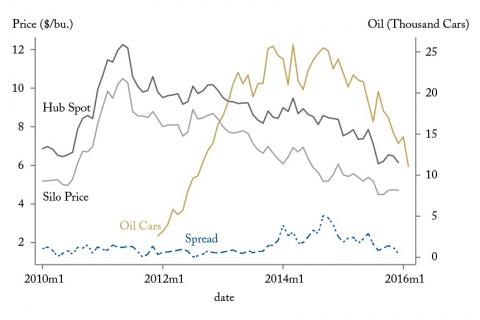From: James Bushnell, Jonathan Hughes and Aaron Smith
To: Regulators and users of the Western Canadian rail network
Date: July 3, 2018
Re: Food vs. Fuel? Impacts of Petroleum Shipments on Agricultural Prices
The shale revolution generated tremendous changes in both the volume and geographical distribution of oil production.
The rapid increase of gas and oil production in the Dakotas and elsewhere outpaced the expansion of traditional pipeline infrastructure and led to a much greater reliance on rail transportation. While the reliance on railways to transport shale oil may have been born of necessity, it could very well be a lasting relationship.
And that portends periodic or even chronic rail transportation capacity constraints becoming the new normal in shale heavy regions. Canada has seen a similar rise in crude oil travelling on the rails, along with concerns from grain farmers about the effect of capacity constraints on the railways.
We examine one of the most notable episodes of the shale transportation phenomenon, the boom in oil-by-rail shipments out of the upper Great Plains since 2010. Annual oil shipments from North Dakota increased from about 26,000 cars in 2010 to more than 340,000 cars in 2014, which was 50 percent of all rail shipments from the state (see figure). The massive increase in oil shipments created congestion in rail networks, which in turn affected the spatial relationship of commodity prices, particularly for wheat.
In an echo of the Canadian experience, reports in 2013 and 2014 highlighted the plight of farmers facing difficulties shipping their grain to markets. Consistent with these reports, we find that the price spreads between wheat production centres and commercial hubs grew substantially during this period, and that oil shipments were an important driver of these changes. Corn and soybean prices were also affected, but by a smaller amount.
The impact of the increase in wheat transportation costs was borne mostly by purchasers of wheat at the Minneapolis commercial hub. Specifically, rail congestion caused relative prices in Minneapolis to increase as mills in that region sought to maintain wheat supplies. Transportation constraints did not substantially reduce prices paid to farmers or increase local wheat storage.
During times of high demand or railway congestion, railwaysds allocate scarce capacity using railcar auctions. A successful bid in a railcar auction guarantees that a rail car will be delivered for loading during a specified time window. Auction prices increased dramatically in 2013-2014 suggesting this, rather than an increase in tariff rates, accounted for the increase in the cost of grain transportation.
These results imply that the railcar auctions were used as a mechanism to allocate scarce capacity to the customers with the highest willingness to pay, namely buyers of wheat in Minneapolis.
James Bushnell is a professor in the Department of Economics at, the University of California, Davis; Jonathan Hughes is an associate professor of economics at the University of Colorado, Boulder; and Aaron Smith is a professor of Agricultural and Resource Economics at the University of California, Davis.
To send a comment or leave feedback, email us at blog@cdhowe.org.
The views expressed here are those of the authors. The C.D. Howe Institute does not take corporate positions on policy matter






